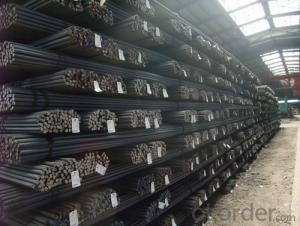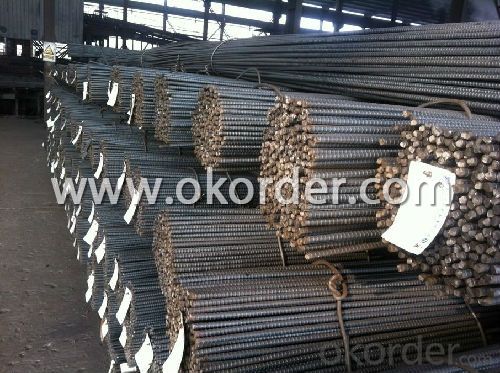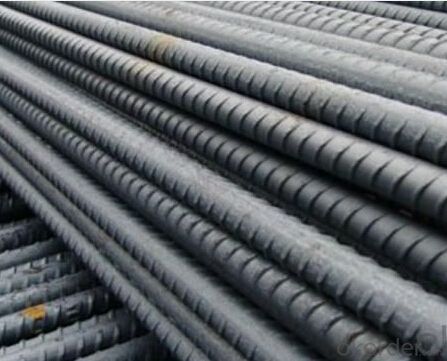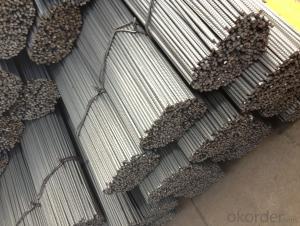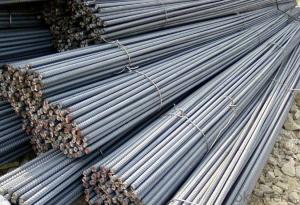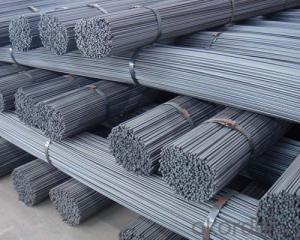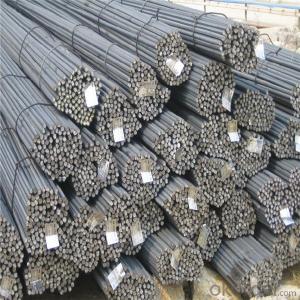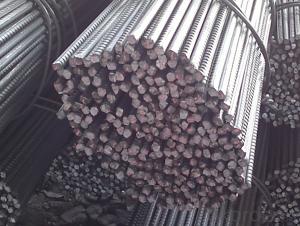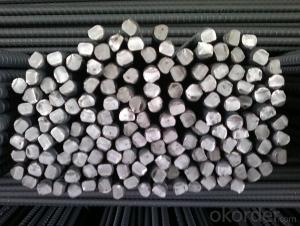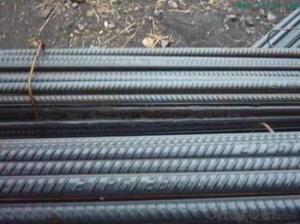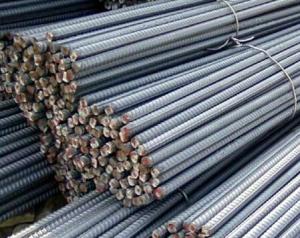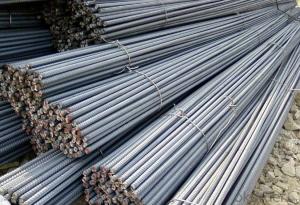Hot Rolled Steel Rebars GB Standard
- Loading Port:
- Tianjin
- Payment Terms:
- TT or LC
- Min Order Qty:
- 50 m.t.
- Supply Capability:
- 100000 m.t./month
OKorder Service Pledge
OKorder Financial Service
You Might Also Like
OKorder is offering Hot Rolled Steel Rebars GB Standard at great prices with worldwide shipping. Our supplier is a world-class manufacturer of steel, with our products utilized the world over. OKorder annually supplies products to African, South American and Asian markets. We provide quotations within 24 hours of receiving an inquiry and guarantee competitive prices.
Product Applications:
Hot Rolled Steel Rebars GB Standard are ideal for structural applications and are widely used in buildings, bridges, roads and other engineering construction. Big to highways, railways, bridges, culverts, tunnels, public facilities such as flood control, dam, small to housing construction, beam, column, wall and the foundation of the plate, deformed bar is an integral structure material..
Product Advantages:
OKorder's Hot Rolled Steel Rebars GB Standard are durable, strong, and wide variety of sizes.
Main Product Features:
· Premium quality
· Prompt delivery & seaworthy packing (30 days after receiving deposit)
· Can be recycled and reused
· Mill test certification
· Professional Service
· Competitive pricing
Product Specifications:
Standard | GB UK USA | HRB335 HRB400 HRB500 G460B, B500A, B500B,B500C GR40, GR60 | |
Diameter | 6mm,8mm,10mm,12mm,14mm,16mm,18mm,20mm, 22mm,25mm,28mm,32mm,36mm,40mm,50mm | ||
Length | 6M, 9M,12M or as required | ||
Invoicing | Actual or Theoretical Weight Basis as buyer’s request. | ||
Type | Hot rolled steel rebar | ||
Diameter(mm) | Section area (mm²) | Mass(kg/m) | Weight of 12m (kg) | Pcs/ton |
6 | 28.27 | 0.222 | 2.664 | 375.38 |
8 | 50.27 | 0.395 | 4.74 | 210.97 |
10 | 78.54 | 0.617 | 7.404 | 135.06 |
12 | 113.1 | 0.888 | 10.656 | 93.84 |
14 | 153.9 | 1.21 | 14.52 | 68.87 |
16 | 201.1 | 1.58 | 18.96 | 52.74 |
18 | 254.5 | 2.00 | 24 | 41.67 |
20 | 314.2 | 2.47 | 29.64 | 33.74 |
22 | 380.1 | 2.98 | 35.76 | 27.96 |
25 | 490.9 | 3.85 | 46.2 | 21.65 |
28 | 615.8 | 4.83 | 57.96 | 17.25 |
32 | 804.2 | 6.31 | 75.72 | 13.21 |
36 | 1018 | 7.99 | 98.88 | 10.43 |
40 | 1257 | 9.87 | 118.44 | 8.44 |
50 | 1964 | 15.42 | 185.04 | 5.40 |
FAQ:
Q1: How many tons of steel products could be loaded in containers?
A1: Usually the steel products are delivered by bulk vessel because of the large quantity and the freight. However, there are no bulk vessel enter some seaports so that we have to deliver the cargo by containers. The 6m steel product can be loaded in 20FT container, but the quantity is changed according to the size, usually from 18tons to 25tons.
Q2: How do we guarantee the quality of our products?
A2: We have established an advanced quality management system which conducts strict quality tests at every step, from raw materials to the final product. At the same time, we provide extensive follow-up service assurances as required.
Q3: How soon can we receive the product after purchase?
A3: Within three days of placing an order, we will arrange production. The normal sizes with the normal grade can be produced within one month. The specific shipping date is dependent upon international and government factors, the delivery to international main port about 45-60days.
Images:
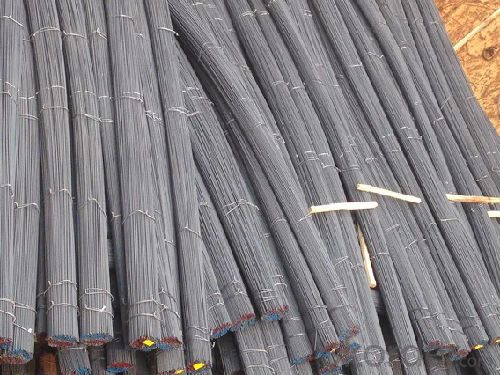
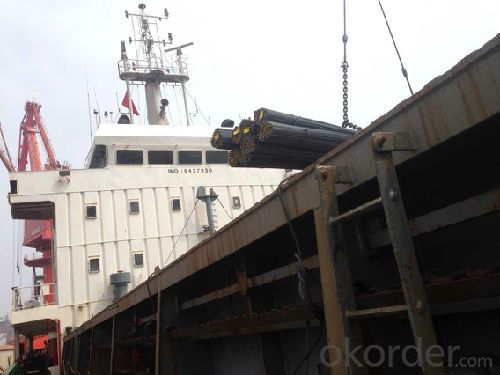
- Q: Can steel rebars be used in cold weather conditions?
- Yes, steel rebars can be used in cold weather conditions. Steel is known for its durability and strength, making it a suitable material for construction projects even in cold climates. However, it is important to take certain precautions when using steel rebars in cold weather. For instance, the rebars should be properly stored and protected from moisture to prevent rusting. Additionally, the concrete mix used with the rebars should be adjusted to ensure it can withstand freezing temperatures and avoid cracking. Overall, with proper planning and precautions, steel rebars can be effectively used in cold weather conditions.
- Q: Can steel rebars be used in structures with high radiation shielding requirements?
- Yes, steel rebars can be used in structures with high radiation shielding requirements. Steel has good radiation shielding properties and is commonly used in such structures to provide protection against radiation.
- Q: Can steel rebars be used in structures with limited construction space?
- Indeed, structures with limited construction space can accommodate the use of steel rebars. In reinforced concrete structures, steel rebars are widely employed to enhance tensile strength and bolster overall structural integrity. Given their diminutive size and pliability, steel rebars can be conveniently maneuvered and installed in cramped areas. They can be easily bent, cut, or shaped to suit the specific demands of the construction project. Moreover, steel rebars can be prefabricated off-site and subsequently transported to the construction site, thereby further facilitating their utilization in constrained construction spaces. All in all, steel rebars represent a versatile and pragmatic option for reinforcing structures with limited construction space.
- Q: Why is the difference between left and right threads? What's the difference?
- Generally, the right-hand thread is in accordance with people's habits, just as the pointer of a clock is right. Compared with the less threaded but is indispensable, it has certain effect, more commonly used threaded on the rotating shaft with a more general rotation shaft are turning to the right, as some pump, motor, fan in the shaft as a tightening wheel for all kinds of leaves threaded, when the impeller rotation relative to the tightening nut, it has a different rotation inertia force, if it is the right-hand thread words will lead to a tightening mother increasingly loose causing impeller loose damaged equipment. This force in the switch machine or a great change in speed when the performance is particularly prominent, so the choice of left-handed thread more and more tight.
- Q: Can steel rebars be used in wastewater treatment plants?
- Yes, steel rebars can be used in wastewater treatment plants. Steel rebars are commonly used as reinforcement for concrete structures, including those found in wastewater treatment plants. The rebars provide strength and durability to the structures, ensuring they can withstand the harsh environments and corrosive nature of wastewater. However, it is important to select the appropriate grade of steel rebars that are resistant to corrosion caused by the chemicals present in wastewater.
- Q: What is the effect of steel rebars on the durability of concrete structures?
- Steel rebars have a significant positive effect on the durability of concrete structures. By reinforcing the concrete, rebars enhance its tensile strength and resistance to cracking and deformation. This added strength helps to prevent structural failures and increases the longevity of the concrete, making it more resistant to environmental factors such as corrosion, earthquakes, and heavy loads. Overall, steel rebars play a crucial role in ensuring the durability and long-term stability of concrete structures.
- Q: What does "4EDT6" mean on thread steel?
- It is a kind of flat steel with a wide thickness and a large surface area. According to the thickness of different thickness of thin sheet (thickness <4mm), medium plate (thickness 4-25mm) and thick plate (thickness >25mm) three. The steel strip is included in the steel plate.
- Q: How do steel rebars affect the fire resistance of a structure?
- Steel rebars can have both positive and negative effects on the fire resistance of a structure. On one hand, steel rebars can enhance the fire resistance of a structure by providing additional strength and stability. The presence of steel rebars in concrete structures can help prevent collapse during a fire, allowing more time for occupants to evacuate and emergency responders to control the situation. However, steel rebars also have some drawbacks when it comes to fire resistance. Steel is a highly conductive material, meaning it can transfer heat quickly. During a fire, the steel rebars can heat up and transfer the heat to the surrounding concrete, potentially weakening its structural integrity. This can result in a reduced fire resistance of the structure. To mitigate the negative effects of steel rebars on fire resistance, certain measures can be taken. One common approach is to apply fire-resistant coatings or wraps to the steel rebars. These coatings or wraps act as a barrier, slowing down the heat transfer from the steel to the concrete, thus enhancing the fire resistance. Additionally, the size, spacing, and arrangement of steel rebars can also impact the fire resistance of a structure. Proper design and placement of rebars can ensure that the heat is distributed more evenly, reducing the risk of localized weakening and structural failure. In summary, steel rebars can have a significant impact on the fire resistance of a structure. While they can enhance the overall strength and stability, they can also contribute to the heat transfer and potential weakening of the structure. By implementing appropriate measures such as fire-resistant coatings and proper design, the negative effects of steel rebars on fire resistance can be minimized, ensuring the safety and integrity of the structure during a fire.
- Q: Can steel rebars be used in foundation systems?
- Yes, steel rebars can be used in foundation systems. Steel rebars, also known as reinforcing bars, are commonly used in concrete structures to enhance their strength and durability. In foundation systems, steel rebars are used to provide reinforcement and prevent cracking or failure of the concrete. They are typically embedded within the concrete to increase its tensile strength and improve its resistance to various external forces such as bending, shearing, and tension. Steel rebars are widely utilized in different types of foundation systems, including shallow foundations, deep foundations, and pile foundations, to ensure the stability and longevity of the structures.
- Q: Can steel rebars be used in dam construction?
- Yes, steel rebars can be used in dam construction. Rebars, which are steel bars used to reinforce concrete structures, provide added strength and durability to the dam. They are typically embedded within the concrete to enhance its tensile strength and prevent cracking under the pressure of the water.
Send your message to us
Hot Rolled Steel Rebars GB Standard
- Loading Port:
- Tianjin
- Payment Terms:
- TT or LC
- Min Order Qty:
- 50 m.t.
- Supply Capability:
- 100000 m.t./month
OKorder Service Pledge
OKorder Financial Service
Similar products
Hot products
Hot Searches
Related keywords
